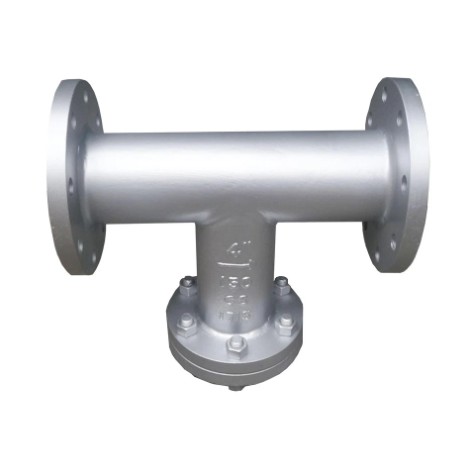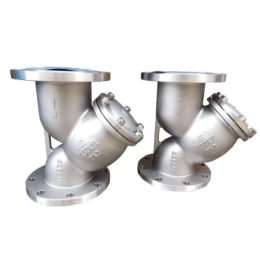
T Strainer
Introduction
The T Strainer has a machined groove in both the body and cover for proper screen alignment, ensuring accurate reseating during servicing. A synthetic fiber gasket is compressed between the body and cover for maximum strength and durability. Upon request, F-V filters can be furnished with a blow-off plug. Standard perforated 304 stainless steel screens are provided for maximum strength, but different size perforations and meshes are available in stainless steel, Monel, and brass to meet specific media requirements. If the media is not indicated, screens for water will be supplied. Self-cleaning is achieved by opening the valve or drain plug connected to the blow-off port.

Technical Specifications:
| Description | Specification |
|---|---|
| Sizes | NPS 1/2 to NPS 48 |
| Pressure Class | 150 to Class 2500 |
| Casting Materials | A216 WCB, WC6, WC9, A350 LCB, A351 CF8, CF8M, CF3, CF3M, A995 4A, A995 5A, A995 6A |
| Other Materials | Alloy 20, Monel, Inconel, Hastelloy |
| Description | Specification |
| Connection | RF, RTJ, or BW |
| Cover | Bolted |
| Screen Type | Perforable or Mesh Lined Stainless Steel |
Design Standard
Design & manufacture according to ASME B16.34
Face-to-face according to ASME B16.10
End Connection according to ASME B16.5 (RF & RTJ), ASME B16.25 (BW)
Test & inspection according to API 598
Advantages of T Strainers

T Strainers have several advantages, including the ability to handle high flow rates while maintaining filtration efficiency. They are also easy to install and maintain, making them popular for many applications. T Strainers protect downstream equipment from damage caused by debris or foreign materials, which can help reduce maintenance costs and improve process efficiency. They can also improve product quality and consistency, especially in applications where the media is dirty or abrasive, by removing unwanted particles and maintaining the purity of the end product.
T Strainers are often used in industries such as chemical, oil and gas, water treatment, food and beverage, and pharmaceutical. They are especially helpful in situations where the media is unclean or abrasive, or where the process demands high purity standards.
The T Strainer is designed with a machined groove in both the body and cover to ensure accurate reseating during servicing. They come with a synthetic fiber gasket that is compressed between the body and cover for maximum strength and durability. The strainer is furnished with a blow-off plug upon request. Standard perforated 304 stainless steel screens are provided for maximum strength, but different size perforations and meshes are available in stainless steel, Monel, and brass to meet specific media requirements. If the media is not indicated, screens for water will be supplied. Self-cleaning is achieved by opening the valve or drain plug connected to the blow-off port.
Applications of T Strainers
T Strainers are commonly used in the following industries:
- Chemical
- Oil and gas
- Water treatment
- Food and beverage
- Pharmaceutical
They are particularly useful in applications where the media is dirty or abrasive, or where the process requires a high level of purity.
Benefits
Some of the key benefits of T Strainers include:
- Protecting downstream equipment from damage
- Reducing maintenance costs
- Improving process efficiency
- Ensuring product quality and consistency
Q&A
Q: What materials are T Strainers made of?
A: T Strainers are typically made of stainless steel, Monel, or brass, but can also be made of other materials depending on the application.
Q: What sizes are available?
A: T Strainers are available in sizes ranging from NPS 1/2 to NPS 48, and can handle pressure classes up to Class 2500.
Q: How often do T Strainers need to be cleaned?
A: The frequency of cleaning will depend on the application and the level of contamination in the media. In general, T Strainers should be cleaned whenever there is a noticeable decrease in flow or pressure.
- Gate Valves Can Be Classified In Two Ways
- Efficient Flow Control with Forged Trunnion Ball Valve
- What to Pay Attention to When Installing Valves?
- “How a Butterfly Valve Works: Control Flow in Oil, Gas, and Chemical Industries”
- Ball Valve Specifications And Functions: Everything You Need To Know
- Why Should the Shut-Off Valve Have Low Inlet and High Outlet?



